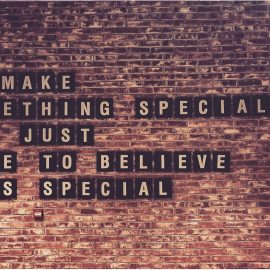

This article is an excerpt from the Shortform book guide to "You Are a Badass at Making Money" by Jen Sincero. Shortform has the world's best summaries and analyses of books you should be reading.
Like this article? Sign up for a free trial here.
Are you ready to make a commitment to becoming wealthy? How can you achieve financial goals?
In You Are a Badass at Making Money, Jen Sincero argues that you must commit fully to your dreams and financial goals. Committing fully means letting go of your contingency plans and making a conscious decision to pursue the path that helps you acquire the money you want.
Let’s look at how to achieve financial goals.
Commit Fully to Your Financial Goals
Learning how to achieve financial goals is important because it shifts your mindset—when you focus all your energy on meeting your true goal instead of spreading it between your different contingency options, you begin looking for ways to make it come true. You’re more willing to take risks, and you have to believe that it’ll work out. There must be at least some chance of the plan working out because you wouldn’t have chosen it in the first place if you didn’t believe it could work.
(Shortform note: If you struggle to maintain a committed mindset despite these benefits, consider telling your financial goals to people whose opinions you value. The fear of disappointing them can help you stay accountable to your goals even when you’re struggling to stay committed for yourself. Also, your loved ones can offer an outside perspective with wisdom that may help you if you run into challenges along the way.)
| When to Commit: Leaps of Faith vs. Bad Decisions When deciding whether and how to fully commit to your financial goals, it may be wise to determine if the decision you’re about to make is a positive leap of faith or just a poor, misinformed choice. Leaps of faith involve risk and may be scary, but they’re based on a love for something and a desire to make a lasting, positive change in your life. Your love for the thing you’re taking a chance on outweighs your fear that it might not work out. Therefore, the risk you’re taking is courageous and for a noble purpose. In contrast, a bad decision is one based on fear. You make it because you’re afraid to take a chance on something better. For example, say you dream of independence and financial security. In one scenario, you decide to go back to school for a degree that will lead to a traditionally lucrative career. However, the new career isn’t actually the one you want—it’s just one you perceive to be secure. You’re afraid that you won’t succeed at what you really want to do, so you choose the easier option. In the other scenario, you take a positive leap of faith: You choose the career you really want, even though it may be less secure. You choose to accept risk for the vocation you love, and you fully commit to it. |
Take One Immediate Action That Will Help You Reach Your Goal
If you’re struggling to commit to your financial goals, Sincero suggests choosing one action that will put you on the path toward building wealth. This action should be something that you can do presently and that feels out of your comfort zone. For instance, taking out a loan for your new business might be the first uncomfortable but necessary step toward acquiring the wealth you desire. Another example could be quitting your stable job to go back to school for a new, more lucrative, and more enjoyable career path.
(Shortform note: Piers Steel (The Procrastination Equation) argues that breaking large, intimidating tasks—such as financial goals—into smaller, manageable action steps works because it encourages small wins. Every time you successfully complete an action, your confidence and motivation increase, propelling you to the next step. Further, other experts support Sincero’s advice to act outside of your comfort zone. Leaving your comfort zone promotes personal growth, and research suggests that challenges provide beneficial exercise for the brain. They make your brain healthier and more adaptable. Finally, challenging yourself leads to further motivation, as you feel proudest when you accomplish something difficult.)
If any limiting subconscious views about money arise because of this first action, write them down. Additionally, if you identify any limiting views, allow yourself to feel any associated emotions, recognize the emotions, and release them.
For example, you might hold the subconscious view that sticking with a seemingly stable career path is more important than doing something you enjoy but that’s less stable (even if you could eventually make more money doing it). When you pause and think about how this view has hindered you, you might feel disappointed that you spent so long doing something you disliked. You might also still experience some fear that you’re making the wrong choice and throwing away a solid career.
(Shortform note: To add a more concrete step to the process of writing down limiting thoughts and releasing negative emotions, consider throwing away the piece of paper when you’re done. A study found that participants who wrote down negative thoughts and subsequently threw them away also released the thoughts mentally. In contrast, participants who wrote their thoughts down but kept the paper were more likely to be influenced by those thoughts when making decisions later on.)
After identifying the subconscious views that were hindering you and processing the resulting emotions, visualize the positive things that might happen as a result of you taking this action. For example, you might imagine yourself getting your dream job after graduating, or you might envision buying all the things you’ve been saving up for when you have a higher-paying job.
(Shortform note: Visualization can help you achieve your financial goals by tricking your brain into thinking you’ve already succeeded. This can help you overcome fear and increase your confidence. When you clearly imagine that something’s happened, your brain responds as if you’re actually experiencing it. Your brain then incorporates the “experience” as a memory. Then, when you come upon the situation you visualized in real life, your brain already knows what to do and how to succeed because it thinks you’ve succeeded before.)

———End of Preview———
Like what you just read? Read the rest of the world's best book summary and analysis of Jen Sincero's "You Are a Badass at Making Money" at Shortform.
Here's what you'll find in our full You Are a Badass at Making Money summary:
- How your limiting beliefs about money are holding you back from wealth
- How to rid yourself of your underlying beliefs about money
- Why being wealthy does not mean taking from others






